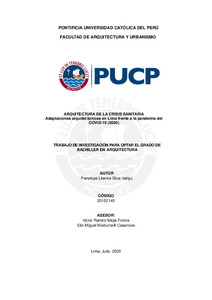| dc.contributor.advisor | Mejía Ticona, Víctor Ramiro | |
| dc.contributor.author | Silva Valqui, Penelope Lilenka | |
| dc.date.accessioned | 2022-01-11T17:47:08Z | |
| dc.date.available | 2022-01-11T17:47:08Z | |
| dc.date.created | 2020 | |
| dc.date.issued | 2022-01-11 | |
| dc.identifier.uri | http://hdl.handle.net/20.500.12404/21255 | |
| dc.description.abstract | La presente investigación analiza las adaptaciones arquitectónicas de tres diferentes
obras en Lima como respuesta a la pandemia del COVID-19. Esta investigación también
identifica los aciertos y desaciertos en las adaptaciones de cada caso, así como
pensar en la posibilidad de replicar los cambios en otros contextos y poner en valor la
versatilidad de los edificios desde su diseño y programa. Para entender la oportunidad
que supone explorar sobre arquitectura modular y la modificación planificada de la infraestructura
preexistente, se tomaron en cuenta ejemplos variados. Desde la adaptación
de las viviendas hasta la construcción de anexos, se toman como casos de estudio
el Hospital Rebagliati (1956), el Anexo del Hospital San Isidro Labrador de Ate
(2003) y la Villa Panamericana (2019). Finalmente, se invita a una reflexión y especulación
del cambio de la arquitectura y las ciudades post-pandemia donde actualmente
no existe una relación entre la posibilidad de adaptar estructuras no planificadas ni
acondicionadas de manera específica a situaciones sanitarias. | es_ES |
| dc.description.abstract | The following research analyzes the architectural adaptations of three different buildings
in Lima as a result of the COVID-19 pandemic. This research subsequently identifies
the success and failures of these adaptations, identifying the potential possibilities
involving the replication of these changes in other contexts and the versatility of buildings
in their program and design. Varied examples are used to understand innovations
now possible using the exploration of modular architecture and planned modifications
of pre existing infrastructure. From adaptations of housing to building annexes, the
case of studies are the Rebagliati Hospital (1956), the annex of the San Isidro
Labrador, Hospital of Ate (2003) and the Villa Panamericana (2019). Finally, this research
ends with a speculation on the post-pandemic future of architecture where
nowadays there’s no relation within a context as such and the possibility of adapting non-planned structures to specific sanitary situations. | es_ES |
| dc.language.iso | spa | es_ES |
| dc.publisher | Pontificia Universidad Católica del Perú | es_ES |
| dc.rights | info:eu-repo/semantics/openAccess | es_ES |
| dc.rights.uri | http://creativecommons.org/licenses/by-sa/2.5/pe/ | * |
| dc.subject | Hospitales--Arquitectura--Adaptación | es_ES |
| dc.subject | Arquitectura--Adaptación | es_ES |
| dc.subject | Arquitectura--Aspectos sanitarios | es_ES |
| dc.subject | COVID-19 (Enfermedad)--Perú | es_ES |
| dc.title | Arquitectura de la crisis sanitaria: adaptaciones arquitectónicas en Lima frente a la pandemia del COVID-19 (2020) | es_ES |
| dc.type | info:eu-repo/semantics/bachelorThesis | es_ES |
| thesis.degree.name | Bachiller en Arquitectura | es_ES |
| thesis.degree.level | Bachillerato | es_ES |
| thesis.degree.grantor | Pontificia Universidad Católica del Perú. Facultad de Arquitectura | es_ES |
| thesis.degree.discipline | Arquitectura | es_ES |
| renati.advisor.dni | 10556604 | |
| renati.advisor.orcid | https://orcid.org/0000-0003-0140-2274 | es_ES |
| renati.author.dni | 78009960 | |
| renati.discipline | 731026 | es_ES |
| renati.juror | Martuccelli Casanova, Elio Miguel | es_ES |
| renati.level | https://purl.org/pe-repo/renati/level#bachiller | es_ES |
| renati.type | https://purl.org/pe-repo/renati/type#trabajoDeInvestigacion | es_ES |
| dc.publisher.country | PE | es_ES |
| dc.subject.ocde | https://purl.org/pe-repo/ocde/ford#6.04.08 | es_ES |






